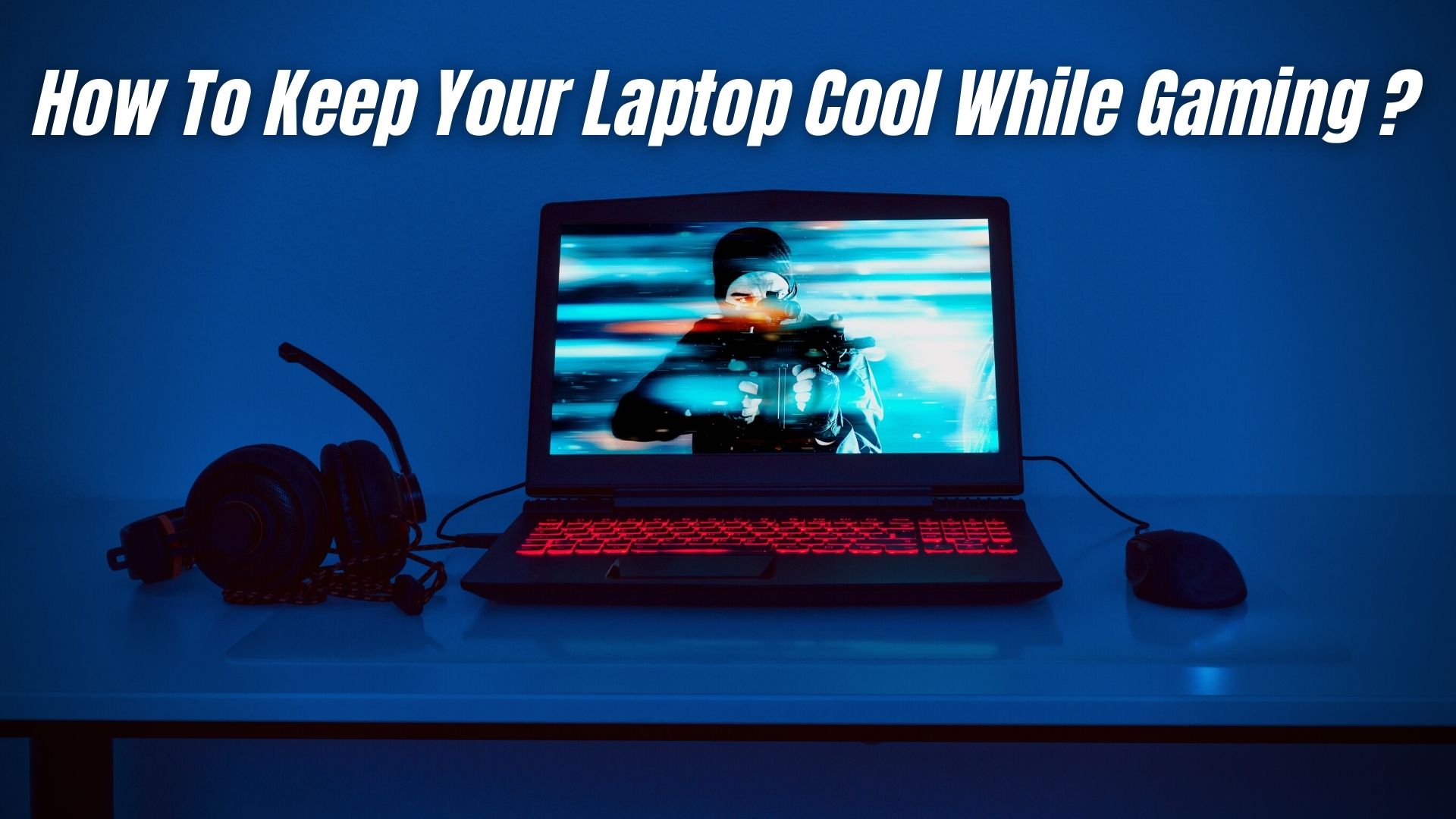Every gamer who uses laptops for gaming must be very familiar with laptop overheating. For the die-hard gamers, the pc getting overheated and shutting down is very common. This is something a gamer can barely ignore. However, many gamers have no clue this is happening because of overheating, and the laptop needs cooling.
Cooling is not only for extracting the best performances from the laptops while gaming. It’s to avoid any hardware malfunction due to overheating as well. Overheating can reduce the lifespan of the pc as well. So, let’s dive right into our guide to understand how you can keep laptop cool while gaming.
How Can I Keep My Laptop Cool While Gaming
All the top laptop manufacturers have brought innovative and advanced methods. They install several high-speed fans, and a cooling vapor chamber. They also use a sliding keyboard for better airflow, flexing the bottom of the laptop for better airflow, etc., to keep the laptop cool.
Because of overheating, there are several problems that one can face in gaming laptops, such as:
- Overheating causes thermal throttling, which decreases the gaming performance
- The laptop can shut down suddenly
- The keyboards can be heated
- Premature failure of the hardware
- A loud noise from the cooling fan
Today, we will discuss how your gaming laptop cool and stop overheating.
1. Ensuring Lower Graphics Settings and FPS

Higher graphics settings can often stress both your processor and the graphics card. It happens especially when playing an extremely demanding game like Metro Exodus or Final Fantasy Fifteen.
Plenty of processing, calculations, and rendering have to be performed while playing games at higher settings. Higher settings mostly lead to a lot of heat production by the processor and the graphics card in the laptop’s interior.
Thus, lowering the graphics settings and limiting frame rate or FPS can enable you to reduce the load on the processor and graphics card. And as a result, these components can run cooler.
2. Replacing the Thermal Paste
If you find your laptop’s thermal grease appearing bad, you should go to change it. If you have an older system, the thermal paste tends to dry up gradually the effectiveness decreases over time. So if you can access your laptop easily, then you should unscrew the cooler and change the paste or replace it with a fresher one.
Thermal paste can improve heat transfer between your CPU and PC’s heat sink. However, thermal paste loses effectiveness gradually, and as a result, it can’t dissipate heat properly. Thus the laptop gets hot.
If you want your thermal paste to work perfectly, then reapplying regularly every 3-4 years to the laptop’s graphics card and the processor is the key to improving conductivity. In that case, have some rubbing alcohol and remove the previous thermal paste.
You can also use liquid metal to replace your laptop’s previously used thermal paste. However, be especially careful while applying the liquid metal as spilling or leaking this on other components can damage your motherboard. Try seeking professional help if the procedure appears to be complex to you.
If you can apply fresh and new thermal paste, you can improve the heat dissipation, which can be really helpful for keeping the laptop cool during heavy and long hours of game playing.
3. Avoid Running Excessive Programs
As the temperature of your laptop’s hardware is linked directly to its load, not running too many programs all at once is a better option than just keeping them running in the background.
Specifically, while playing high-resolution games, you must quit other programs that are not required to be run at that moment. While running one program at a time is not harming you, why let so many programs run all at once?
4. Optimization of Game Settings
Putting the game settings to maximum makes the game playing experience vivid and enjoyable. However, if your gaming laptop’s graphics card is not capable enough of performing at maximum settings, you won’t be able to experience the gameplay as much as you desire.
Additionally, your laptop will have immense pressure on it to run the game and turn hotter. It’s one of the major reasons gaming laptops get overheated. To avoid this issue, try to ensure that your game settings are not set to the max level. Instead, select the game settings that are most compatible with your laptop.
5. Keeping the Laptop Clean
After continuous use for a long time, laptops attract lots of dust and several other materials that can clog the air intake and exhaust the vents. While there is enough dust built up in the laptop’s interior, the airflow gets severely restricted, resulting in overheating the laptop.
If you want to avoid lining up dust and other harmful materials inside your laptop, you must clean up your laptop once a year. Many people might have suggestions to blow compressed air inside the laptop through vents to help get rid of the dust. But this mostly results in dissipating the dust and the other materials inside the interior rather than getting rid of the dust.
One of the best ways to clean the laptop is by taking the laptop apart. In that case, all you would require is just a screwdriver. However, if you are not confident enough with this, you can go for an expert technician. But this is relatively easy, and if you try, you can do it. Once you clean the laptop, the airflow will be improved, and this will help the laptop be cool during gaming hours.
6. Choose a Flat Surface for Using the Laptop

You can see in almost every laptop that the air intake vent is positioned right at the bottom of the body. As a result, you always need a bit of space between the laptop’s surface and the bottom panel for the air to flow freely and cool down the components.
Using the laptop on soft surfaces can prove to be a bad idea as the surfaces get folded up and curled, which can block the vents of air intake entirely. It results in the rise of the temperatures in the laptop’s interior to a significantly alarming level.
So, to prevent this problem, try to ensure using your laptop on a flat, hard surface while gaming. Use Lap desks when using the gaming laptop on the bed.
7. Undervolting and Underclocking
You can prevent your laptop from overheating if you Undervolt your CPU and GPU. Just lower the voltage at which the graphics and the processor can operate. The heat generation will automatically lessen when there are power restrictions defined for your processor and your graphics card.
In the case of Underclocking, this thing does reduce the calculation number processed by the processor and the graphics card each second. As a result, the stress on both components gets reduced, which allows them to run cooler.
Popular opinions will suggest you use Intel XTU for underclocking and undervolting the processor. Your laptop’s thermal load will be reduced and more power-efficient. For the same function, another useful software is the Throttlestop, which can help you monitor the temperatures and control the CPU voltage and the clocking speed.
Use MSI Afterburner software for underclocking and undervolting your PC’s GPU. It allows to adjust the fan speed and makes the laptop run without noise.
8. Stop Running Any Unnecessary Program
Your laptop can be under huge stress if it has been assigned multitasking or does have several programs running simultaneously. The laptop’s processor gets serious stress, and plenty of heat is generated due to this. So always try to close unnecessary programs running in the background. Running fewer programs as possible will help you cool down your laptop while gaming.
In that case, you can use Windows Task Manager to see which tasks and programs are currently running. Use keyboard shortcuts such as Ctrl+Shift+Esc, Alt+Ctrl+ Delete, or Win+X to open your laptop’s application for windows task manager.

In this application, a list of activities and running programs will be visible right in front of you, and from here, you will know which activities you don’t want to be running right now. You can right-click on the processes by which an option of ‘End Task’ will appear at the bottom of the menu. Choose the End Task option to close the process.

This is how you can reduce the load on the laptop, and this can certainly help cool down the laptop. This can also help run anti-malware software like Malwarebytes while scanning or removing malware.
Several Malware can put unnecessary and extra strain on your laptop’s resources. Thus these should be eliminated.
9. Replace The Fans

One of the reasons behind your laptop’s overheating is the faulty fans. You will see your laptop getting overheated, once the fans can’t meet the required spinning speed or stop working entirely.
Error messages are popping up when the cooling fans malfunction. Also, there are times when the fans get entirely disabled and do not spin at all. The faulty fans are mostly noisy and do not spin freely even after giving them a push with the fingers.
Replace your faulty fans can improve the air intake of the laptop and the air circulation of the interior, which can keep the temperature under control and cool.
10. Use Laptop Cooling Pads
When you’ll see the laptop not being able to cool down on itself, go for a cooling pad and use it to cool down the laptop. Cooling pads can reduce the temperatures of the laptop up to 10 °C. Though it depends on the cooling pad, you are using.
Cool pads feature one large fan, whereas other cooling pads come with multiple smaller fans. Cooling pads blow air into your laptop’s air vents situated at the bottom, increasing the airflow around the laptop. The air circulation is thus improved, and the laptop can intake more air freely.
11. Choose a Cooler Environment for Gaming

Sometimes the outer atmosphere makes your laptop go hotter. During the months of Summer, the laptops heat up because of the external heat. It happens because the room temperature is up, making the environment hotter. So, to avoid this kind of heating, keep the room temperature between 10-35 °C for gaming.
Keeping the temperature within this range can help the laptop’s cooling system keep the interior’s optimal temperature at the required rate. However, if you find the room temperature to be above 35°C, consider gaming in an air-conditioned to prevent the laptop from overheating.
12. Adjust the Fan Speed
The fan speed of your PC increases along with the temperature increase of your CPU or GPU. However, there are times when the fan configuration settings can not sync and go wrong, which causes the computer to be overheated.
So it is necessary to check the BIOS settings to ensure whether the fan settings have been properly configured or not.
Go to the BIOS settings, select advanced settings, and go for hardware monitor configuration. Under this section, you will find the configuration settings for Fan. Set them to default, or you can also manually input values as per your custom requirement. If you fail to adjust the fan speed from BIOS, then use SpeedFan software to help you adjust the fans speed depending on outer temperature.
Conclusion
From the discussion above, you must already know you should prevent your laptop from getting overheated. While gaming, the average CPU and GPU temperatures should be maintained between 70 -80°C. But if it exceeds 80°C, then most of the gaming laptops will throttle, and if it is around 99°C, then ‘Automatic Shut Down’ will prevent permanent damage to the hardware. To monitor the temperatures of your laptop’s CPU and GPU, you can try core temp software.
If you love your laptop and don’t know how to prevent it from overheating. Then the tips mentioned above can cool your laptop while gaming.






